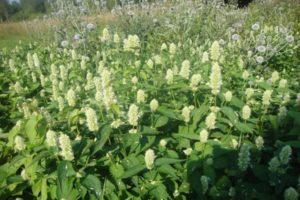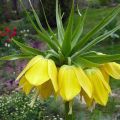Planting, growing and caring for gladioli outdoors
Gladiolus (skewer) belongs to the group of flowers demanded by Russian gardeners for its unpretentiousness and colorful flowering. Moreover, the plant has long been considered a weed. Regardless of the type of gladioli chosen, planting and caring for a flower does not cause any particular difficulties even for inexperienced gardeners. However, this does not mean that the plant will grow anywhere and without appropriate feeding.
Description and characteristics of the plant
Gladiolus is the common name for flowers in the Iris family, which includes over 250 plant varieties. In Russia, mainly hybrid varieties are grown, obtained by crossing European and African. Due to the wide variety of flowers, it makes sense to consider the characteristics of certain types of gladioli that are in demand among gardeners:
- Moscow White stone. The length of the gladiolus grows up to 150 centimeters. White flowers on a straight stem reach 14 centimeters in diameter. No more than 8 buds bloom on one trunk at a time. This variety begins to bloom in July.
- Krasava. An early variety of gladioli. The first yellow flowers bloom in early June. Krasava has a long stem. Up to 24 buds are formed on one trunk.
- Priscilla. On the gladioli of this variety, flowers bloom white-pink with a raspberry edging. The barrel length does not exceed 100 centimeters.
- Amber Baltic. 160 cm gladiolus with large flowers (up to 15 cm in diameter) light red in color. Up to 23 buds bloom on one trunk.
- Grand Duchess Elizabeth. A non-standard variety of gladioli, characterized by a small stem (up to 70 centimeters) and abundant flowering (up to 22 buds). The flowers are distinguished by a combination of orange and pink hues.
Despite the different flowering times, gladioli are planted in early spring. For each of the varieties, there are the same requirements for the place of growth and care. In addition to the above, breeders have also bred varieties of gladioli, distinguished by compact flowers. But due to the fact that the plant grows straight up and is characterized by a small crown, each variety can be grown in a flower bed of any size.
How to choose gladiolus bulbs before planting?
For planting, it is not recommended to take bulbs with spots. The latter indicate that the plant is infected.It is also not recommended to take large bulbs, since the flower has spent a lot of energy on the formation of such a root crop. Because of this, the likelihood that the gladiolus will take root in a new place is reduced.
Bulbs with a diameter of 2-4 centimeters, with one sprout 3-7 millimeters long and a skin of a reddish or dark golden hue are considered optimal for planting.

Features of growing flowers
For the successful cultivation of gladioli outdoors, the following rules must be observed:
- Flowers must be replanted to a new location every 2 years.
- It is recommended to transplant into soil with a different composition (from black soil to loam, and so on).
- Plant varieties adapted to a specific climate on the site.
- Do not plant large and small bulbs nearby, as the latter will not grow.
- Follow the recommendations for planting depth, otherwise the stem will not break through the thickness of the earth.
Gladioli are distinguished by the fact that they do not tolerate prolonged drought, abundant and frequent watering, as well as the lack of sunlight and draft. The plant does not bloom in such conditions and is often sick.
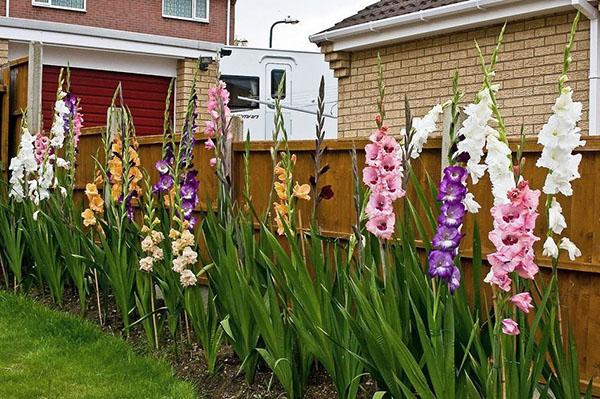
When to plant
It is recommended to plant bulbs in spring. In this case, the soil should warm up (up to 10 degrees), avoid the threat of night frosts. If this rule is observed, then the plant will bloom in August.
Seat selection
Gladioli are grown in well-ventilated and sunny places, protected from strong winds. Flowers do not tolerate being close to cruciferous plants and carrots. Also, you cannot plant bulbs in a place where potatoes previously grew. This provokes a wireworm infection.
Soil preparation
The soil for gladioli must be prepared in the fall. It is recommended to apply potash, phosphorus and nitrogen fertilizers to acidic soil. Also, these soils are fertilized with lime or dolomite flour. In the place where the bulbs are planted, a drainage layer must be created, which will prevent decay of the rhizomes.
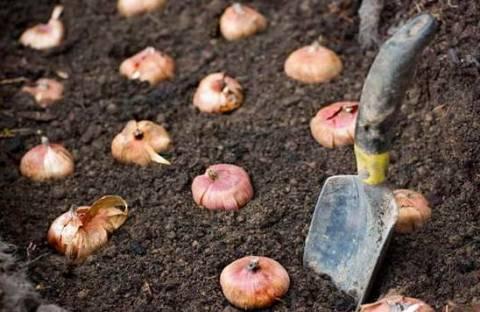
In heavy soils, a pillow should be created by pouring 10 centimeters of river sand into a previously dug hole. The latter will ensure the outflow of excess moisture.
Preplant preparation of corms
2 weeks before planting, the hard shell is removed from the bulbs and laid out on a flat surface on which diffused light falls. Before transferring the material to the soil, the tubers must be kept for 1-2 hours in a solution of potassium permanganate or 1 hour in Fundazole. It is recommended to plant those bulbs in which the rudiments of the stems are clearly visible on the surface. The presence of two kidneys is allowed. But when growing, such a flower must be watered and fed more often.
Planting scheme and depth
Gardeners adhere to the following rules for burying root bulbs:
- if compact bulbs are planted, then the plant is buried 3-5 centimeters;
- medium bulbs - 8-10 centimeters;
- large - 12-15 centimeters.
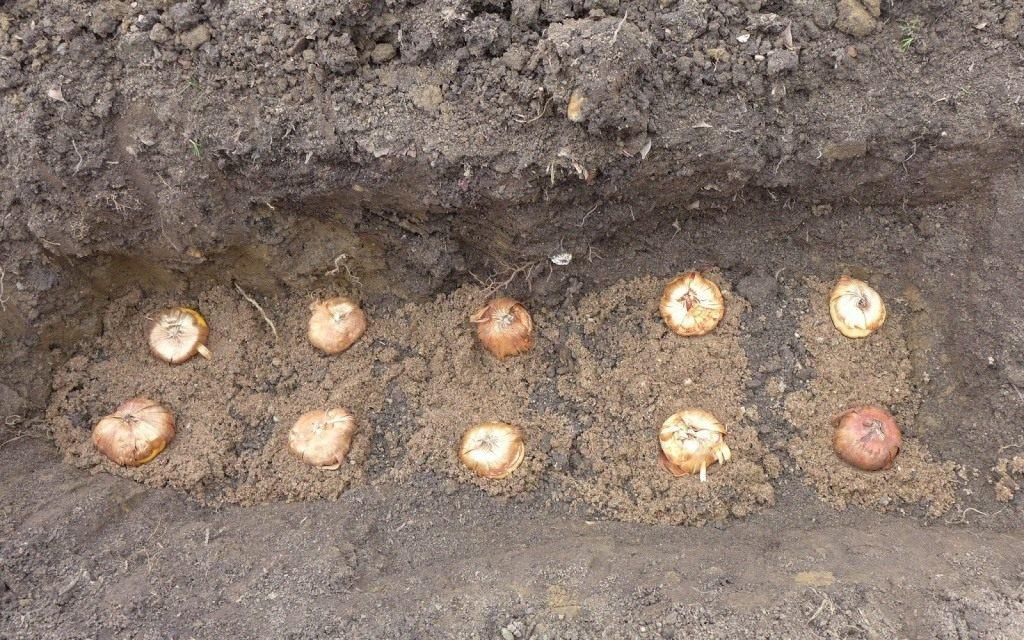
The bulbs are planted in pre-prepared furrows, on the bottom of which a layer of sand or sphagnum is preliminarily laid out. After that, the earth is moistened. Gladioli are planted at a distance of 15-20 centimeters. The next furrow in the bed is dug at a distance of 20-25 centimeters.
At the end, the bulbs are covered with earth. After several days, when shoots appear, it is necessary to add soil near the root of the plant, thereby strengthening the stem.
If gladioli are grown in sandy loam or light soil, then the bulbs are deepened by 1-2 centimeters more than recommended. Otherwise, the adult plant will bend to the ground.
Rules for the care of gladioli
You need to start caring for gladioli after the first shoots appear. Already in the initial period of growth, the flower will require fertilization and periodic watering.

Mulching
To reduce the frequency of watering, it is recommended to mulch the plant after the stems are 10 centimeters long.To do this, a 5-centimeter layer of humus is introduced under the flower.
Watering
In the warm season, gladioli are watered once a week. In dry periods, this procedure is recommended to be carried out every other day. During the hot period, the plant requires daily watering. This should be done in the evening, before weeding the beds. Water for irrigation needs to be heated.
Fertilizer
Gladioli are fertilized according to the following scheme:
- When the length of the stem reaches 10 centimeters, organic fertilizers (compost or humus) are applied under the plant.
- After the formation of 3-4 full-fledged leaves, a mixture of 2 tablespoons of ammonium sulfate or urea and 10 liters of water is added. This volume is enough to fertilize one square meter. After application, the top dressing should be deepened by one centimeter.
- During the formation of 5-6 leaves and during budding, phosphorus-potassium fertilizers are applied.

In the warm season, it is also recommended to feed the flower with infusion of bird droppings diluted in water in a ratio of 1:10 once every two weeks.
Garter
Large gladioli must be tied up. For this, various designs are used. In particular, gardeners place sticks at each flower. You can also drive stakes along the perimeter of the garden bed and stretch between the rows of wire, tying a flower to each.
Disease and pest control
In the treatment and prevention of diseases of gladioli are used:
- solution of soda ash or baking soda (against fungus);
- solutions of Fufanon, Karbofos or Decis (against earwigs);
- garlic (against rot and fusarium), which is planted in a garden with gladioli (the affected roots must be destroyed);
- superphosphate, ash or tobacco ash (from slugs);
- Karate or Fastak (from thrips and aphids).

Solutions should be used to treat the flower immediately after signs of infection appear. Ash and tobacco ash must be scattered between the rows.
When to dig up plants?
It is recommended to dig up the bulbs for storage in winter 35-40 days after the end of flowering. This procedure must be carried out on a dry day. The early varieties are dug first, and then the later ones. In this case, the stems need to be cut, leaving only the bulbs.
Storing gladiolus bulbs
After digging, the bulbs must be rinsed under running water and disinfected in Fundazole solution. Next, gladioli must be laid out to dry for 2-3 days.
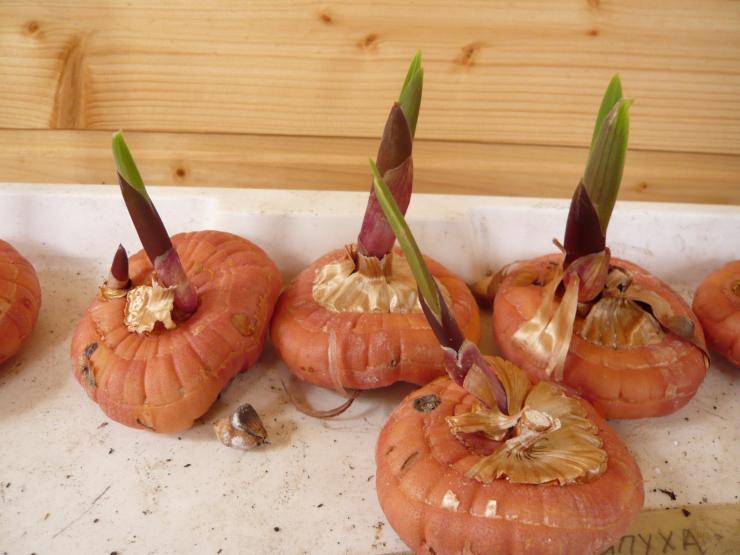
After preparing for winter, the bulbs are placed on the bottom of a paper box and placed in the room. You need to store the plant at a temperature of 5-10 degrees and an average humidity of 60-70%. In order to prevent infection, heads of garlic should be put to the bulbs, changing the last every month.
Features of growing in other regions of Russia
The cultivation of gladioli in Siberia and the Urals is associated with certain difficulties, since in these regions summer is shorter and comes later. In this regard, it is recommended to first plant the bulbs in pots at home, and after the first shoots appear, transfer them to open ground. Flowers can be grown in closed greenhouses if needed.
Where to buy gladiolus bulbs?
Gladiolus bulbs can be purchased at almost any flower shop. Each plant must be examined before purchasing, discarding the affected ones.

